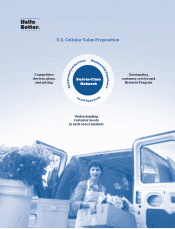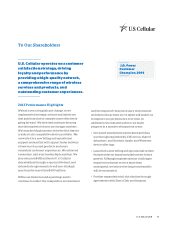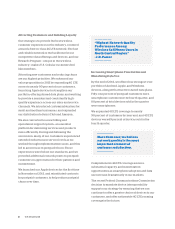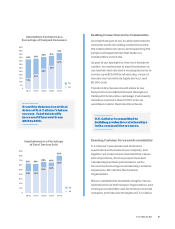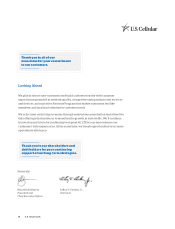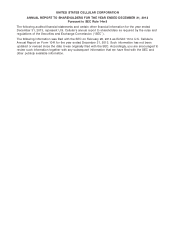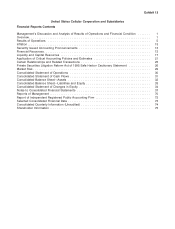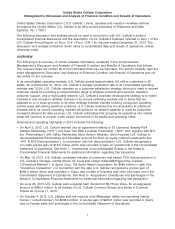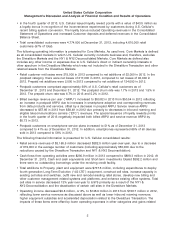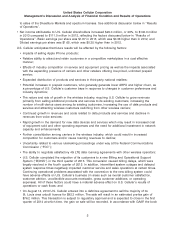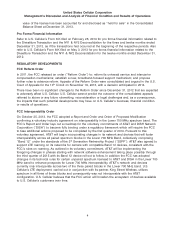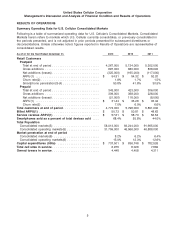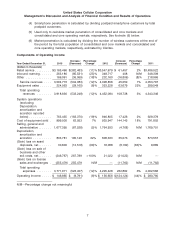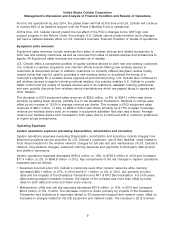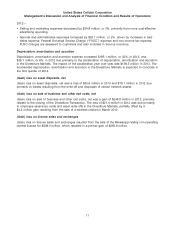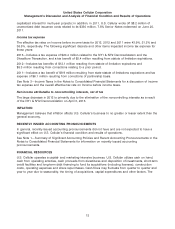US Cellular 2013 Annual Report Download - page 11
Download and view the complete annual report
Please find page 11 of the 2013 US Cellular annual report below. You can navigate through the pages in the report by either clicking on the pages listed below, or by using the keyword search tool below to find specific information within the annual report.United States Cellular Corporation
Management’s Discussion and Analysis of Financial Condition and Results of Operations
to sales of the Divestiture Markets and spectrum licenses. See additional discussion below in ‘‘Results
of Operations’’.
• Net income attributable to U.S. Cellular shareholders increased $29.0 million, or 26%, to $140.0 million
in 2013 compared to $111.0 million in 2012, reflecting the factors discussed below in ‘‘Results of
Operations’’. Basic earnings per share was $1.67 in 2013, which was $0.36 higher than in 2012, and
Diluted earnings per share was $1.65, which was $0.35 higher than in 2012.
U.S. Cellular anticipates that future results will be affected by the following factors:
• Impacts of selling Apple iPhone products;
• Relative ability to attract and retain customers in a competitive marketplace in a cost effective
manner;
• Effects of industry competition on service and equipment pricing as well as the impacts associated
with the expanding presence of carriers and other retailers offering low-priced, unlimited prepaid
service;
• Expanded distribution of products and services in third-party national retailers;
• Potential increases in prepaid customers, who generally generate lower ARPU and higher churn, as
a percentage of U.S. Cellular’s customer base in response to changes in customer preferences and
industry dynamics;
• The nature and rate of growth in the wireless industry, requiring U.S. Cellular to grow revenues
primarily from selling additional products and services to its existing customers, increasing the
number of multi-device users among its existing customers, increasing the use of data products and
services and attracting wireless customers switching from other wireless carriers;
• Continued growth in revenues and costs related to data products and services and declines in
revenues from voice services;
• Rapid growth in the demand for new data devices and services which may result in increased cost
of equipment sold and other operating expenses and the need for additional investment in network
capacity and enhancements;
• Further consolidation among carriers in the wireless industry, which could result in increased
competition for customers and/or cause roaming revenues to decline;
• Uncertainty related to various rulemaking proceedings under way at the Federal Communications
Commission (‘‘FCC’’);
• The ability to negotiate satisfactory 4G LTE data roaming agreements with other wireless operators;
• U.S. Cellular completed the migration of its customers to a new Billing and Operational Support
System (‘‘B/OSS’’) in the third quarter of 2013. This conversion caused billing delays, which were
largely resolved in the fourth quarter of 2013. In addition, intermittent system outages and delayed
system response times negatively impacted customer service and sales operations at certain times.
Continuing operational problems associated with the conversion to the new billing system could
have adverse effects on U.S. Cellular’s business (in areas such as overall customer satisfaction,
customer attrition, uncollectible accounts receivable, gross customer additions, or operating
expenses). All of these factors could have a material adverse effect on U.S. Cellular’s results of
operations or cash flows; and
• On August 14, 2013 U.S. Cellular entered into a definitive agreement to sell the majority of its
St. Louis area unbuilt license for $92.3 million. The sale will result in an estimated pre-tax gain of
$76.2 million. This transaction is subject to regulatory approval and is expected to close in the first
quarter of 2014 at which time, the gain on sale will be recorded. In accordance with GAAP, the book
3


